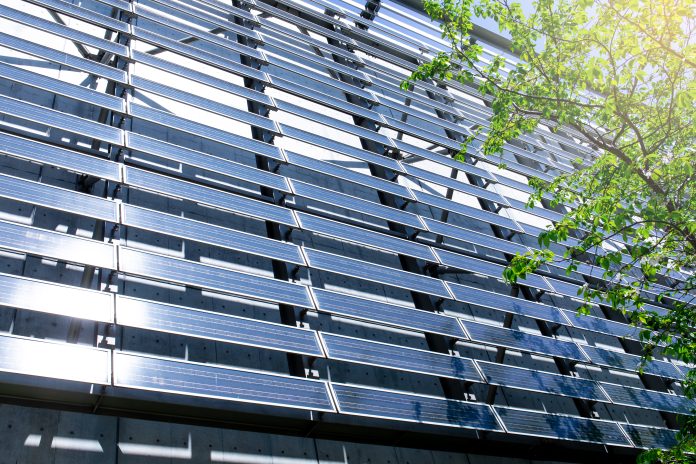Efforts to decarbonise UK public buildings must speed up significantly to reach net zero targets, a new report has warned
A new report examining efforts to decarbonise UK public buildings has found that the government risks missing its 75% CO2 emission reduction target – by 101 years.
The Public Building Energy Efficiency Report, conducted by Neos Networks, examined the actual energy usage and efficiency of over 450,000 public buildings in England and Wales.
CO2 emissions from public buildings need to be reduced five times faster than they’re currently falling to meet the target of ‘75% reduction in CO2 emissions by 2037’.
The report projects that nine out of ten (91%) public buildings will need upgrading in the next seven years – if they’re to meet net zero targets.
Efforts to decarbonise public buildings vary wildly across the UK
Neos Networks analysed the display energy certificates (DECs) and ‘operational ratings’ (annual CO2 emission kg per m2) of public buildings, and highlighted the areas requiring immediate action and major investment in retrofitting public building stock.
On average across England and Wales, CO2 emissions per m2 have fallen by 0.62% annually over the last 15 years.
An annual reduction of 3.75% is needed to achieve the core goal of a 75% reduction in CO2 emissions by 2037, compared to the 2017 benchmark as outlined in the UK government’s ‘Net Zero’ and ‘heat and buildings’ strategies.
However, there is a mixed picture across the local authorities. Public buildings in a third (32%) of local authorities have seen an increase in their CO2 emissions per m2. In some areas, operational rating emissions have risen by over 70%.
By contrast, more than two-thirds (68%) of local authorities brought emissions down. Merthyr Tydfil (-68.20%), East Hertfordshire (-54.23%) and Portsmouth (-54.35%) were the best performers, highlighting what’s possible with targeted investment.
What’s needed to improve energy efficiency in public buildings?
The data highlights the need for swift action. Almost 13% of public buildings fall below the current minimum energy efficiency standards (MEES) EPC rating of E for non-domestic buildings, based on their latest display energy certificate score.
Central government funding for local authorities fell by over 50% in real terms between 2010–11 and 2020–21, according to government committee reports.
The report findings reignite calls for government investment to support local authorities improving the energy efficiency of schools, NHS facilities and other public buildings.
‘Greater support from central government is needed’
William Harris, senior account director, Public Sector at Neos Networks: “These findings highlight the size of the task ahead if authorities are to meet targets. It’s clear that greater support from central government is needed – and investment in network connectivity across public buildings is a crucial first step.”
“This will enable more effective data collection and analysis – to make informed decisions about the public building stock in each area. Then there can be a targeted approach, guided by specialists, to investing in CO2 emission reduction measures where the need is greatest.”
Heat pumps and PV panels must be considered in retrofitting efforts
Darren Evans, founder of the net zero construction consultancy firm Darren Evans:
“A lot of public buildings were designed as ‘pieces of art’ – especially in London. The external insulation and deep retrofit that would usually be required to significantly upgrade these buildings would involve covering up the aesthetic features, so this is holding performance back. The buildings also tend to be rather unique, so a ‘one size fits all’ approach is also not possible, resulting in higher material and design costs, and added difficulty in securing funding for projects.“
“Electrification of heat hasn’t yet been widely adopted in the public sector which could help reduce CO2 emissions. All gas should be removed in favour of heat pump technology. PV panels should be on all available roof areas – this will help keep the heat pump running costs in check and further decarbonise the buildings in question. All public buildings with large hot water demand should review waste water heat recovery technology too, and see if it is retrofittable.”
Heat networks could also present a solution
Daniel Scott, vice president, Danfoss Climate Solutions, Northern Europe Region, Danfoss, said:“Around 40% of the energy consumed in cities can be attributed to buildings and one of the most effective steps that can be taken to reduce the CO2 emissions from public buildings is to make their energy systems more effective. Heating and cooling are the biggest energy consumers in public buildings and more efforts need to be made to prioritise solutions that use less energy overall.”
“Excess heat is the world’s largest untapped source of energy and yet there are very few efforts to reuse it. Many public buildings are located close to other sources of heat, such as data centres, supermarkets or Underground stations. There is tremendous potential for capturing this excess heat and reusing it to heat local public buildings. In the Greater London area alone, we have identified 648 eligible excess heat sources that could potentially share their heat through a district energy system. All of this is possible with technology that is readily available today. We urgently need to accelerate the progress of energy efficiency in public buildings. After all, the greenest energy is the energy we don’t use.”














